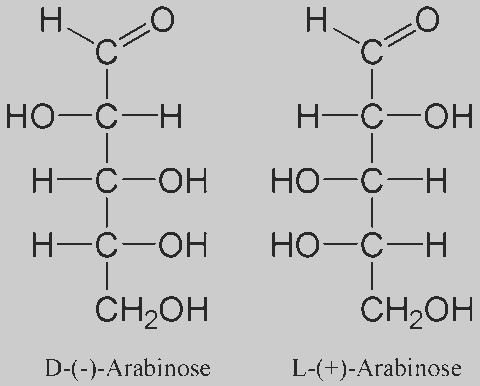Formula C5H10O5 Density 1.58 g/cm³ | Molar mass 150.13 g/mol | |
 | ||
Appearance Colorless crystals as prisms or needles | ||
Arabinose operon
Arabinose is an aldopentose – a monosaccharide containing five carbon atoms, and including an aldehyde (CHO) functional group.
Contents
For biosynthetic reasons, most saccharides are almost always more abundant in nature as the "D"-form, or structurally analogous to D-glyceraldehyde. However, L-arabinose is in fact more common than D-arabinose in nature and is found in nature as a component of biopolymers such as hemicellulose and pectin.
The L-arabinose operon, also known as the araBAD operon, has been the subject of much biomolecular research. The operon directs the catabolism of arabinose in E. coli, and it is dynamically activated in the presence of arabinose and the absence of glucose.

A classic method for the organic synthesis of arabinose from glucose is the Wohl degradation.
The arabinose operon
Etymology
Arabinose gets its name from gum arabic, from which it was first isolated.
Use in biology

In synthetic biology, arabinose is often used as a one-way or reversible switch for protein expression under the Pbad promoter in E. coli. This on-switch can be negated by the presence of glucose or reversed off by the addition of glucose in the culture medium which is a form of catabolite repression.

Some organic acid tests check for the presence of arabinose, which may indicate overgrowth of intestinal yeast such as Candida albicans or other yeast/fungus species.
Use in foods
Originally commercialized as an sweetener, arabinose is an inhibitor of sucrase, the enzyme that breaks down sucrose into glucose and fructose in the small intestine. This inhibitory effect has been validated both in rodents and humans. Therefore, arabinose could be used in foods to attenuate the peak of glycemic response after the consumption of sucrose. The long-term effects of arabinose consumption on blood glucose parameters such as HbA1c and fasting blood glucose levels are unknown. Foods that contain arabinose are usually designed for prediabetic and diabetic patients. These foods are especially popular in Japan and China, where arabinose is legally used as an food additive.

Arabinose is a potential prebiotic, because it cannot be absorbed by human intestine and could be utilized by probiotics such as bifidobacteria. This claim requires further validation.

